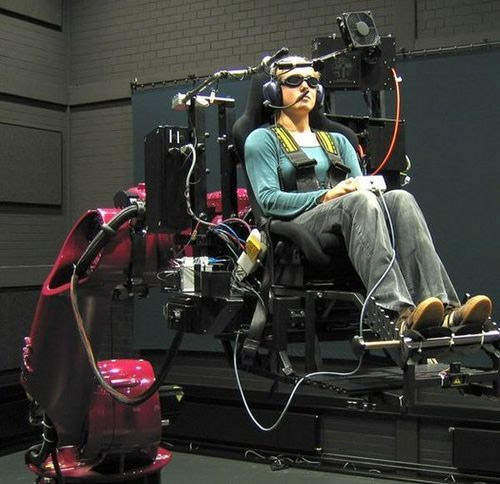21 August 2010 - Nothing is as pleasing for a fan as to have an experience of driving a Ferrari without buying one. Well, it may not be in the real world but Paolo Robuffo Giordano and colleagues at the Max Planck Institute for Biological Cybernetics in Tübingen, Germany have created a Cyber-Motion simulator at the end of a robotic arm to replicate the experience of driving a Ferrari. Players sit in a cabin on the tip of the robotic arm which is about 7 feet off the ground and drives a Ferrari F2007 car around a projected track.
The Cyber-Motion simulator – which is a full motion simulator – features a force-feedback steering wheel and pedals to make experience as realistic as possible. The robotic arm used for the purpose is a Robocoaster, a modified six-axis Kuka KR 500 that can lift up to 500 kg. The basic idea behind using the robotic arm as a motion simulator is to study how humans experience the sensation of motion.
"A motion simulation system is a fundamental tool to understand how humans experience the sensation of motion," he says. "By running suitable experiments, one can gain better insights into the cognitive processes of the human brain."
Most motion simulators usually use six-axis actuated hexapods or Stewart platforms to recreate motion; the CAE 5000 is a typical flight simulator that moves on six cylindrical jacks. But lab director Heinrich Bulthoff wanted to use a robotic manipulator arm to study multi-sensory motion perception, and F1 racing seemed like a challenging way to test the notion.
"The main challenges were related to the adaption or extension of existing motion control algorithms," says Robuffo Giordano, who worked on the F1 arm as a control and robotics engineer. "Our system offers a much larger motion envelope [than Stewart platforms], allowing subjects to be freely displaced in six degrees of freedom in space and even be placed upside-down."
The video above shows what it's like to turn the KUKA 500 into an F1 car. You can hear the loud whine of the arm as the driver takes the curves in the simulation of the famed Monza track. The 3D visuals of the course were created by Robuffo Giordano's colleagues Joachim Tesch and Martin Breidt. Not bad for a DIY arcade game.
Compared to standard simulators, the Cyber-Motion simulator uses a full range of motions and can also turn players upside down. They have even documented the race simulation process in video form, as a test subject hurtles his car round the Monza track. Feedback between the game and mechanical arm was so good that it only had a delay of 40 miliseconds.
Applications for this technology is countless, as it could be applied to other types of simulators such as planes, helicopters, ships, or even in Formula 1 itself. For now the team are working on expanding its range of motion even further.
Source: ieee spectrum



